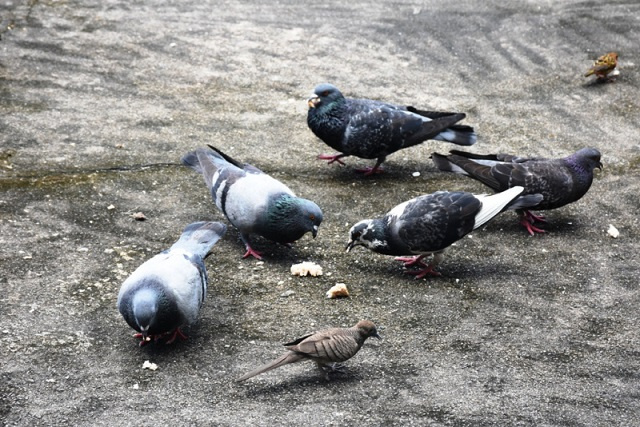
Pest animals aren’t limited to rats, raccoons or squirrels. In urban areas, the most common nuisances are pest birds, like wild pigeons, house sparrows, cockatoos, swallows and starlings, which can all wreak havoc on your landscape by building nests in undesirable places and leaving droppings that can cause health risks.
Pest birds like pigeons, starlings, and gulls can damage solar panels, rooftop ventilators, security cameras, lighting systems, AC units, and water runoff systems by gnawing on the wires and cables.
The main concern with the bird species is caused by their nesting materials. If a wild pigeon chooses to nest on your roof its nesting material can build up in gutters, drains, and downspouts, which can cause serious damage to your roof and drainage systems if left untreated. The accumulation of nest materials also provides a new home not only for these nuisance birds but also the parasites and diseases that they can carry. If the nest isn’t cleared or even continues to grow, this could allow these parasites to get into your home or business, potentially causing serious health risks to you and your family, employees or customers.
In addition to the unwanted nests and related nuisances, birds also leave your yard or building vulnerable to the accumulation of droppings, which, come spring, can cause very messy problems – especially when it starts to get rainy. Spring is the perfect time to add deterrent devices and structures to your property, helping turn away birds that have stayed through the winter months and keeping away migratory birds that return when the warmer season arrives.
Seychelles’ environment ministry concerned about feral pigeons, invasive crows
July 4, 2020
Pothin said a major concern is the continuous feeding of pigeons at schools and by other members of the public. (Seychelles Nation)
The Ministry of Environment, Energy and Climate Change in Seychelles has expressed concerns over the rising population of feral pigeons and recent sightings of the Indian House Crow, which is considered a threat to the local biodiversity and needs to be eliminated.
A conservation officer from the biodiversity conservation section of the ministry told the press last week that these species are not only a threat for the islands’ unique and fragile ecosystem but are a concern for human health.
Ashley Pothin said that tackling the population of feral pigeon and locating and eliminating the introduced Indian House Crow is now an urgency.
“Feral pigeons are considered as an invasive species, a nuisance species and hazard to human health and safety and contribute towards high maintenance costs of infrastructures as a result of accumulated faecal matters,” said Pothin.
The growing population of the feral pigeons can be noticed in the capital city of Victoria, at Ile du Port and Providence – both areas on the outskirts of the city. Between the three sites, a population of around 1,000 birds could be observed. At Ile Du Port, the situation is very apparent at the Palais Justice where the pigeon’s droppings could be found all over its once pristine white façade.
State schools have also been badly affected by the pigeons. In the past, there were several attempts to trap and control these species, but there was little success.
Pigeon feces blamed for Japanese electricity blackout
By Lee Moran | New York Daily News | September 04, 2013
Pigeons feces is being blamed for an electricity blackout in regions in Japan that knocked out some 25,000 traffic lights.

Pigeon poop is being blamed for causing blackouts and massive traffic jams in Japan.
Drivers in Shiojiri and Matsumoto were left stuck in traffic after a buildup of droppings on an electricity substation’s insulator short-circuited street signals.
Energy company bosses said around three feet of excrement had been allowed to pile up, resulting in power being knocked out across the area.
Some 25,000 traffic lights and hundreds of homes reportedly lost power because of the bird dung.
Cops were forced out into the streets to direct traffic by torches last Wednesday, reports Japan Today.
CombirepelTM is a product manufactured by C Tech Corporation which is an anti-rodent, anti-insect, and anti-bird polymer additive specially designed for a range of polymeric applications.
CombirepelTM in the form of the masterbatch can be incorporated into polymeric applications like wires and cables, pipes, agriculture mulch films, etc.
CombirepelTM Bird repellent gel lacquer is a product produced by C Tech Corporation to prevent the menace caused by birds. This product is specially designed to prevent birds from perching and roosting. Repellent evokes a physiological effect that the birds associated with sensory cues and then learn to avoid it.
The lacquer can be applied on the bird’s perching and roosting areas to prevent their infestation and thereby avoid damage.
The Bye-Bye Birdie Spray can be easily sprayed on windows, roofs, beams, trusses, outdoor AC units, etc. to prevent roosting.
Thus using the bird’s sensory mechanism we can get rid of them without causing them any physical harm.
Contact us at technical.marketing@ctechcorporation.com to keep the pests away.
Also, visit our websites:
1] http://www.ctechcorporation.com/
2] http://www.rodrepel.com/
3] http://www.termirepel.com/
4] http://www.combirepel.com/
Follow our Facebook pages at:
1] https://www.facebook.com/Combirepel-411710912249274/
2] https://www.facebook.com/Termirepel-104225413091251/
3] https://www.facebook.com/Rodrepel-120734974768048/
Follow us on our Twitter pages at:
1] https://twitter.com/rodrepel
2] https://twitter.com/termirepel
3] https://twitter.com/combirepel

